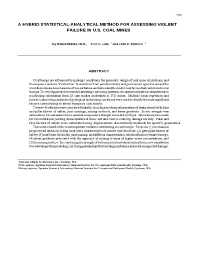Mining Publication: A Hybrid Statistical-Analytical Method for assessing Violent Failure in U.S. Coal Mines
Original creation date: January 1999
Coal bumps are influenced by geologic conditions, the geometric design of coal mine excavations, and the sequence and rate of extraction. Researchers from private industry and government agencies around the world have studied mechanisms of violent failure and have identified individual factors that contribute to coal bumps. To develop predictive tools for assessing coal bump potential, the authors initiated a comprehensive study using information from 25 case studies undertaken in U.S. mines. Multiple linear regression and numerical modeling analyses of geological and mining conditions were used to identify the most significant factors contributing to stress bumps in coal mines.
Authors: H Maleki, EG Zahl, JP Dunford
Information Circular - January 1999
NIOSHTIC2 Number: 10012073
Proceedings of the Second International Workshop on Coal Pillar Mechanics and Design, Pittsburgh, PA: National Institute for Occupational Safety and Health, (NIOSH) 99-114, IC-9448, 1999 Jun; :139-144
See Also
- Coal Bumps and Odd Dynamic Phenomena - A Numerical Investigation
- Development of Guidelines for the Design of Support Systems to Manage Coal Mine Rib Hazards
- Diagnosing and Controlling Moisture-Sensitive Roof in Coal Mines
- Effect of Longwall Face Advance on Spontaneous Heating in Longwall Gob Areas
- Elastic and Shear Moduli of Coal Measure Rocks Derived from Basic Well Logs Using Fractal Statistics and Radial Basis Functions
- Electromagnetic Noise in Itmann Mine
- Numerical Modeling Procedures for Practical Coal Mine Design
- Peak Methane Concentrations During Coal Mining: An Analysis
- Propagation of UHF Radio Waves in Limestone Room and Pillar Mines
- Stochastic Modeling of Gob Gas Venthole Production Performances in Active and Completed Longwall Panels of Coal Mines
- Content source: National Institute for Occupational Safety and Health, Mining Program


 ShareCompartir
ShareCompartir
